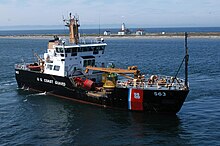USCGC Henry Blake
Henry Blake's primary mission is the maintenance of 80 lighted, 39 unlighted, and 65 shore-based aids to navigation in the Puget Sound area and along the coast of Washington.
Secondary missions include marine environmental protection, search and rescue, and homeland security.
She sailed from Marinette to her base in Everett, stopping in four countries and eleven states, finally reaching her new home on 14 September 2000.
[9] Rather than building the ship from the keel up as a single unit, Marinette Marine used a modular fabrication approach.
Keeper-class ships were the first Coast Guard cutters equipped with Z-drives, which markedly improved their maneuverability.
This gives Henry Blake the ability to hold position in the water even in heavy currents, winds, and swells.
In addition, there were 8 land-based personnel in a cutter support team who augmented the sea-going portion of the crew.
[13] Henry Blake, as all Keeper-class ships, has a strengthened "ice belt" along the waterline so that she can work on aids to navigation in ice-infested waters.
Higher grades of steel were used for hull plating in the ice belt to prevent cracking in cold temperatures.
As she tends aids to navigation in her namesake's former area of responsibility, Henry Blake's motto is "Keeper of the Tradition."
[18] The bulk of Henry Blake's year is spent at sea tending its buoys, or in port maintaining the ship.
In June 2012 a yacht with four people aboard was reported on fire 20 miles northwest of Grays Harbor, Washington.
[20][21] On the morning of 30 September 2016 a Kenmore Air floatplane crashed into the sea near the south end of Lopez Island, Washington.
Old generators, a fuel tank, and nine pallets of miscellaneous gear were lifted off the island by an HH-60 Jayhawk helicopter and set down on Henry Blake's buoy deck so they could be hauled away.
[23] In August 2022, Henry Blake was dispatched to the west side of San Juan Island where the fishing boat Aleutian Isle had recently sunk.
Nets from the vessel floated around the wreck, a hazard to both wildlife and the salvage operations which attempted to prevent a fuel spill.
[25] The biofuel was obtained from the U.S. Navy which was also testing it on its own ships as part of its Great Green Fleet initiative.


